LSCI 1301: Water Problems, Causes, and Solutions in Tourism
VerifiedAdded on 2022/09/05
|9
|2019
|15
Report
AI Summary
This report addresses the critical issue of water problems in tourist destinations, highlighting the overexploitation of water resources due to the increasing demands of the tourism industry. The report identifies the rise of commercial tourism as a primary cause, leading to habitat loss, eutrophication, and alteration of coastal outlines. It examines the ecological, economic, and social implications, including threats to marine life and the disruption of marine food chains. The report proposes solutions such as effective legislation, adherence to environmental regulations, and the implementation of water prevention frameworks for hotels and restaurants. It also discusses the merits and demerits of the proposed strategies, and offers recommendations, including the need for sustainable practices and waste management. The report concludes by emphasizing the importance of balancing commercial interests with environmental conservation and the implementation of stringent regulations to mitigate water pollution and resource degradation.
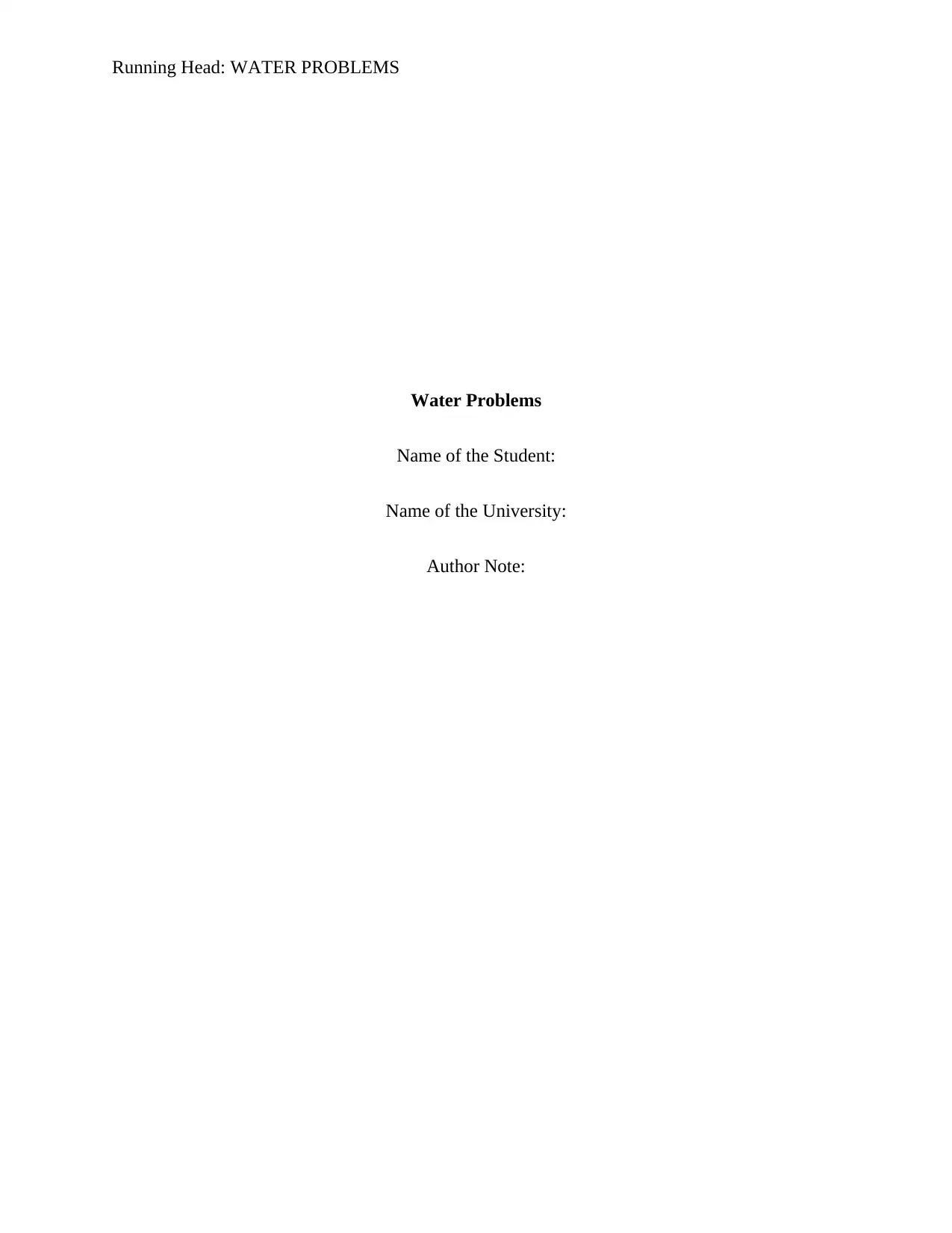
Running Head: WATER PROBLEMS
Water Problems
Name of the Student:
Name of the University:
Author Note:
Water Problems
Name of the Student:
Name of the University:
Author Note:
Paraphrase This Document
Need a fresh take? Get an instant paraphrase of this document with our AI Paraphraser
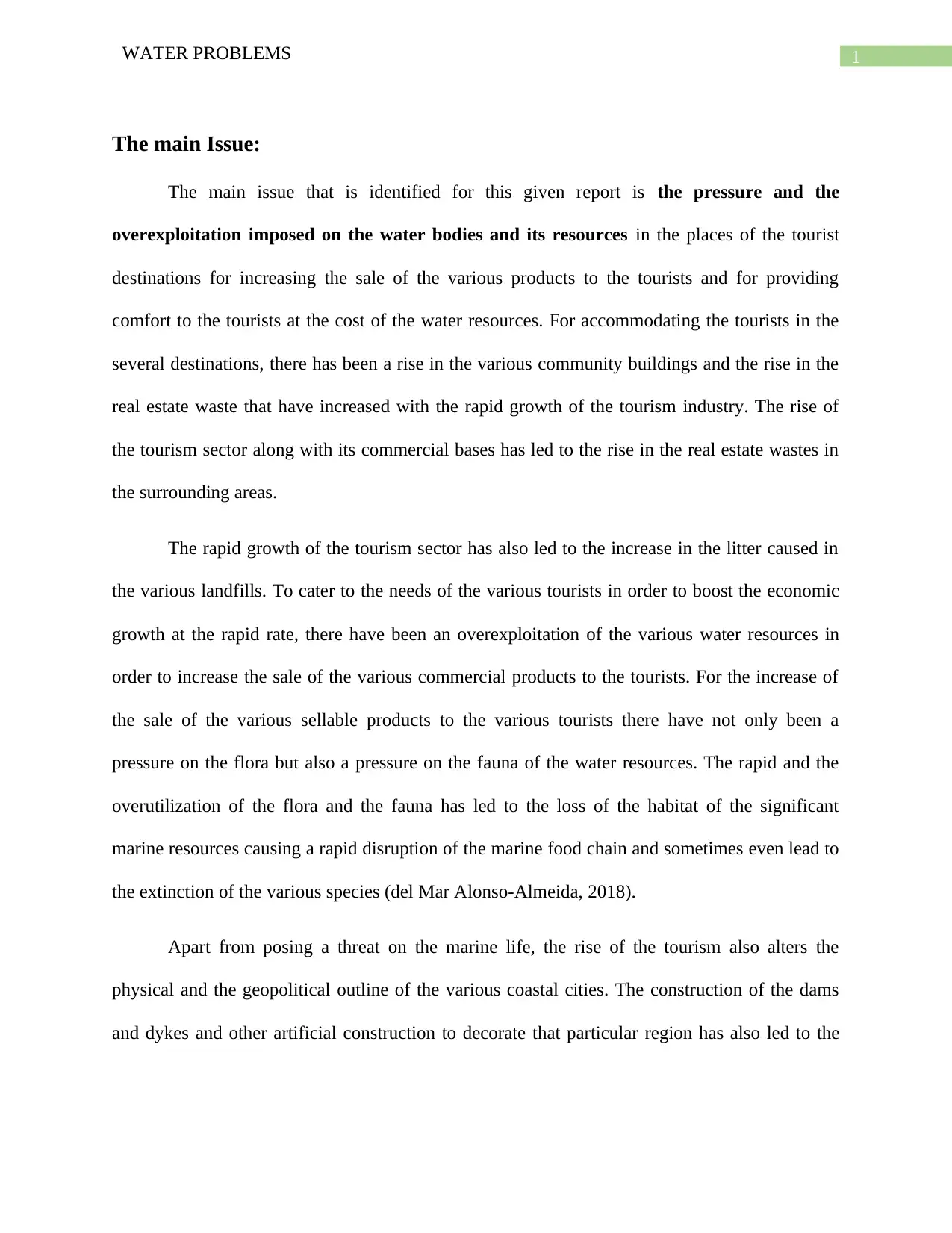
1WATER PROBLEMS
The main Issue:
The main issue that is identified for this given report is the pressure and the
overexploitation imposed on the water bodies and its resources in the places of the tourist
destinations for increasing the sale of the various products to the tourists and for providing
comfort to the tourists at the cost of the water resources. For accommodating the tourists in the
several destinations, there has been a rise in the various community buildings and the rise in the
real estate waste that have increased with the rapid growth of the tourism industry. The rise of
the tourism sector along with its commercial bases has led to the rise in the real estate wastes in
the surrounding areas.
The rapid growth of the tourism sector has also led to the increase in the litter caused in
the various landfills. To cater to the needs of the various tourists in order to boost the economic
growth at the rapid rate, there have been an overexploitation of the various water resources in
order to increase the sale of the various commercial products to the tourists. For the increase of
the sale of the various sellable products to the various tourists there have not only been a
pressure on the flora but also a pressure on the fauna of the water resources. The rapid and the
overutilization of the flora and the fauna has led to the loss of the habitat of the significant
marine resources causing a rapid disruption of the marine food chain and sometimes even lead to
the extinction of the various species (del Mar Alonso-Almeida, 2018).
Apart from posing a threat on the marine life, the rise of the tourism also alters the
physical and the geopolitical outline of the various coastal cities. The construction of the dams
and dykes and other artificial construction to decorate that particular region has also led to the
The main Issue:
The main issue that is identified for this given report is the pressure and the
overexploitation imposed on the water bodies and its resources in the places of the tourist
destinations for increasing the sale of the various products to the tourists and for providing
comfort to the tourists at the cost of the water resources. For accommodating the tourists in the
several destinations, there has been a rise in the various community buildings and the rise in the
real estate waste that have increased with the rapid growth of the tourism industry. The rise of
the tourism sector along with its commercial bases has led to the rise in the real estate wastes in
the surrounding areas.
The rapid growth of the tourism sector has also led to the increase in the litter caused in
the various landfills. To cater to the needs of the various tourists in order to boost the economic
growth at the rapid rate, there have been an overexploitation of the various water resources in
order to increase the sale of the various commercial products to the tourists. For the increase of
the sale of the various sellable products to the various tourists there have not only been a
pressure on the flora but also a pressure on the fauna of the water resources. The rapid and the
overutilization of the flora and the fauna has led to the loss of the habitat of the significant
marine resources causing a rapid disruption of the marine food chain and sometimes even lead to
the extinction of the various species (del Mar Alonso-Almeida, 2018).
Apart from posing a threat on the marine life, the rise of the tourism also alters the
physical and the geopolitical outline of the various coastal cities. The construction of the dams
and dykes and other artificial construction to decorate that particular region has also led to the
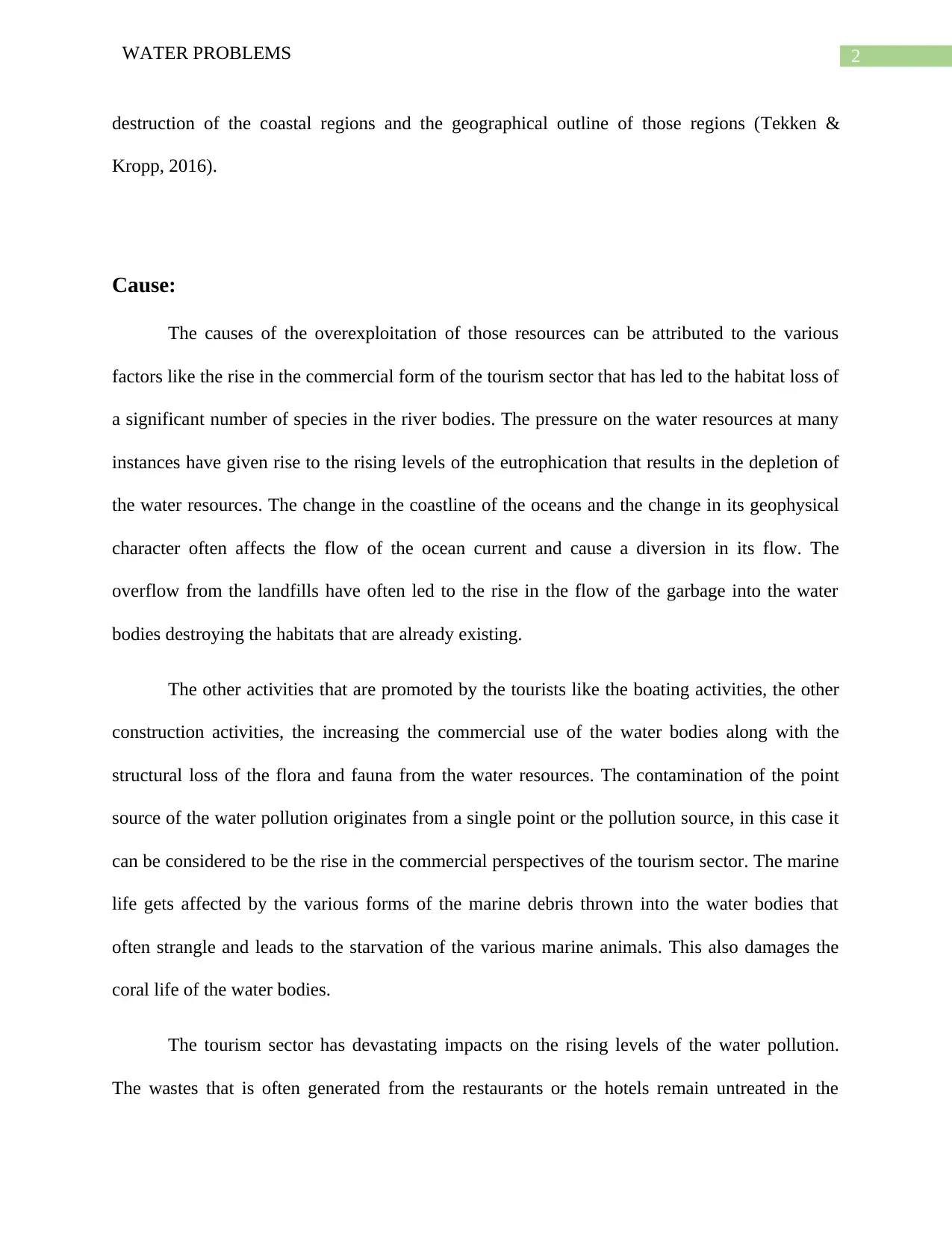
2WATER PROBLEMS
destruction of the coastal regions and the geographical outline of those regions (Tekken &
Kropp, 2016).
Cause:
The causes of the overexploitation of those resources can be attributed to the various
factors like the rise in the commercial form of the tourism sector that has led to the habitat loss of
a significant number of species in the river bodies. The pressure on the water resources at many
instances have given rise to the rising levels of the eutrophication that results in the depletion of
the water resources. The change in the coastline of the oceans and the change in its geophysical
character often affects the flow of the ocean current and cause a diversion in its flow. The
overflow from the landfills have often led to the rise in the flow of the garbage into the water
bodies destroying the habitats that are already existing.
The other activities that are promoted by the tourists like the boating activities, the other
construction activities, the increasing the commercial use of the water bodies along with the
structural loss of the flora and fauna from the water resources. The contamination of the point
source of the water pollution originates from a single point or the pollution source, in this case it
can be considered to be the rise in the commercial perspectives of the tourism sector. The marine
life gets affected by the various forms of the marine debris thrown into the water bodies that
often strangle and leads to the starvation of the various marine animals. This also damages the
coral life of the water bodies.
The tourism sector has devastating impacts on the rising levels of the water pollution.
The wastes that is often generated from the restaurants or the hotels remain untreated in the
destruction of the coastal regions and the geographical outline of those regions (Tekken &
Kropp, 2016).
Cause:
The causes of the overexploitation of those resources can be attributed to the various
factors like the rise in the commercial form of the tourism sector that has led to the habitat loss of
a significant number of species in the river bodies. The pressure on the water resources at many
instances have given rise to the rising levels of the eutrophication that results in the depletion of
the water resources. The change in the coastline of the oceans and the change in its geophysical
character often affects the flow of the ocean current and cause a diversion in its flow. The
overflow from the landfills have often led to the rise in the flow of the garbage into the water
bodies destroying the habitats that are already existing.
The other activities that are promoted by the tourists like the boating activities, the other
construction activities, the increasing the commercial use of the water bodies along with the
structural loss of the flora and fauna from the water resources. The contamination of the point
source of the water pollution originates from a single point or the pollution source, in this case it
can be considered to be the rise in the commercial perspectives of the tourism sector. The marine
life gets affected by the various forms of the marine debris thrown into the water bodies that
often strangle and leads to the starvation of the various marine animals. This also damages the
coral life of the water bodies.
The tourism sector has devastating impacts on the rising levels of the water pollution.
The wastes that is often generated from the restaurants or the hotels remain untreated in the
⊘ This is a preview!⊘
Do you want full access?
Subscribe today to unlock all pages.

Trusted by 1+ million students worldwide
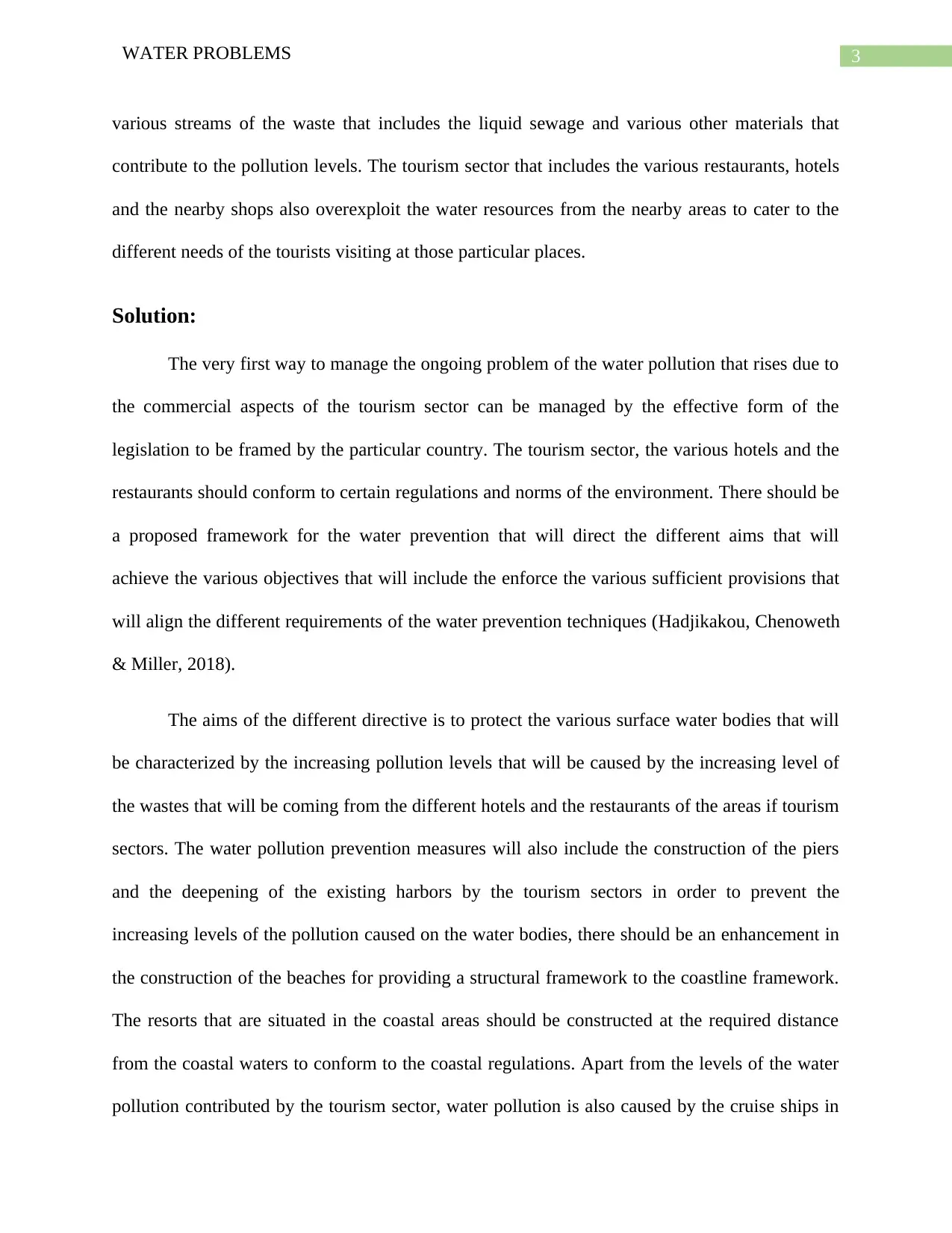
3WATER PROBLEMS
various streams of the waste that includes the liquid sewage and various other materials that
contribute to the pollution levels. The tourism sector that includes the various restaurants, hotels
and the nearby shops also overexploit the water resources from the nearby areas to cater to the
different needs of the tourists visiting at those particular places.
Solution:
The very first way to manage the ongoing problem of the water pollution that rises due to
the commercial aspects of the tourism sector can be managed by the effective form of the
legislation to be framed by the particular country. The tourism sector, the various hotels and the
restaurants should conform to certain regulations and norms of the environment. There should be
a proposed framework for the water prevention that will direct the different aims that will
achieve the various objectives that will include the enforce the various sufficient provisions that
will align the different requirements of the water prevention techniques (Hadjikakou, Chenoweth
& Miller, 2018).
The aims of the different directive is to protect the various surface water bodies that will
be characterized by the increasing pollution levels that will be caused by the increasing level of
the wastes that will be coming from the different hotels and the restaurants of the areas if tourism
sectors. The water pollution prevention measures will also include the construction of the piers
and the deepening of the existing harbors by the tourism sectors in order to prevent the
increasing levels of the pollution caused on the water bodies, there should be an enhancement in
the construction of the beaches for providing a structural framework to the coastline framework.
The resorts that are situated in the coastal areas should be constructed at the required distance
from the coastal waters to conform to the coastal regulations. Apart from the levels of the water
pollution contributed by the tourism sector, water pollution is also caused by the cruise ships in
various streams of the waste that includes the liquid sewage and various other materials that
contribute to the pollution levels. The tourism sector that includes the various restaurants, hotels
and the nearby shops also overexploit the water resources from the nearby areas to cater to the
different needs of the tourists visiting at those particular places.
Solution:
The very first way to manage the ongoing problem of the water pollution that rises due to
the commercial aspects of the tourism sector can be managed by the effective form of the
legislation to be framed by the particular country. The tourism sector, the various hotels and the
restaurants should conform to certain regulations and norms of the environment. There should be
a proposed framework for the water prevention that will direct the different aims that will
achieve the various objectives that will include the enforce the various sufficient provisions that
will align the different requirements of the water prevention techniques (Hadjikakou, Chenoweth
& Miller, 2018).
The aims of the different directive is to protect the various surface water bodies that will
be characterized by the increasing pollution levels that will be caused by the increasing level of
the wastes that will be coming from the different hotels and the restaurants of the areas if tourism
sectors. The water pollution prevention measures will also include the construction of the piers
and the deepening of the existing harbors by the tourism sectors in order to prevent the
increasing levels of the pollution caused on the water bodies, there should be an enhancement in
the construction of the beaches for providing a structural framework to the coastline framework.
The resorts that are situated in the coastal areas should be constructed at the required distance
from the coastal waters to conform to the coastal regulations. Apart from the levels of the water
pollution contributed by the tourism sector, water pollution is also caused by the cruise ships in
Paraphrase This Document
Need a fresh take? Get an instant paraphrase of this document with our AI Paraphraser
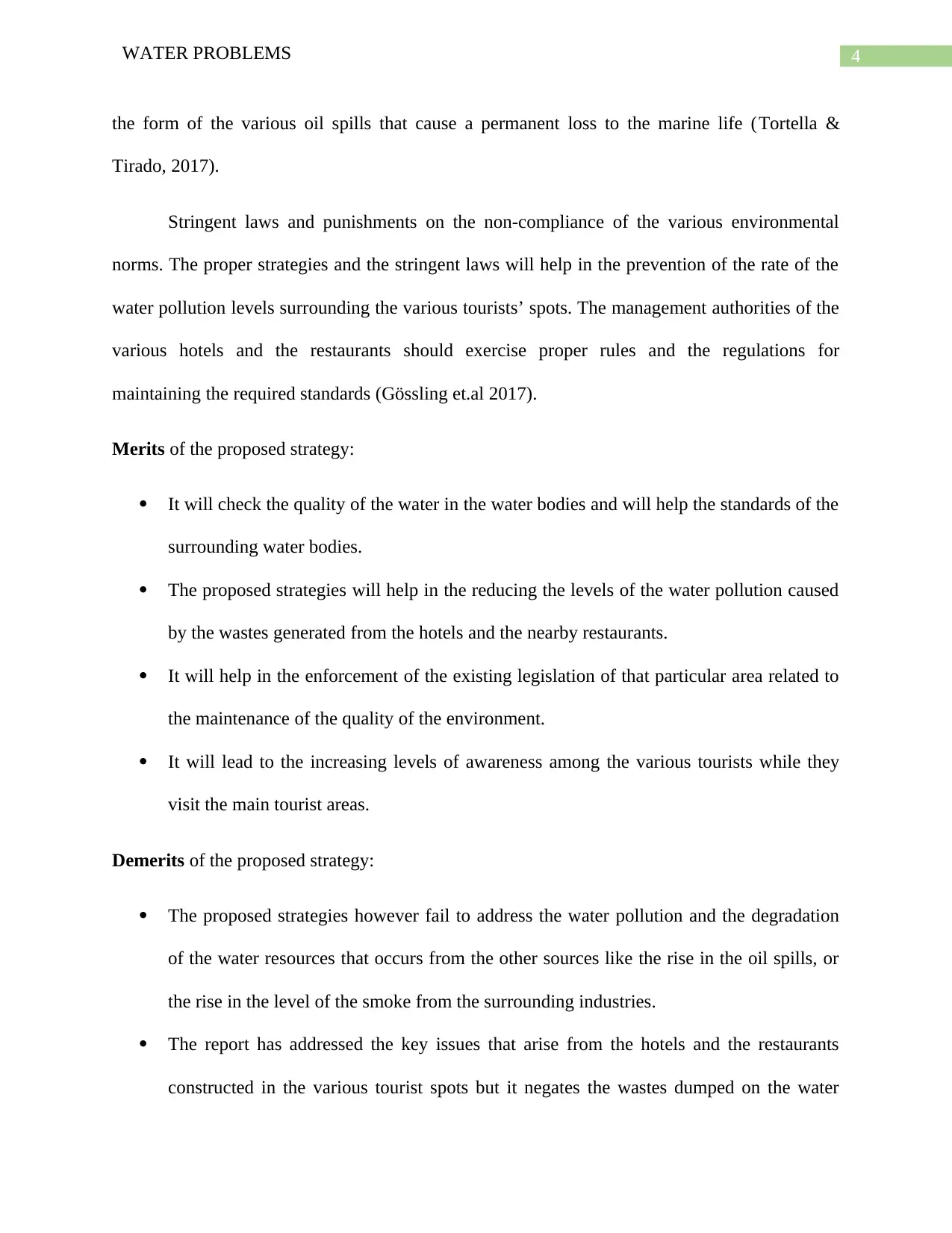
4WATER PROBLEMS
the form of the various oil spills that cause a permanent loss to the marine life (Tortella &
Tirado, 2017).
Stringent laws and punishments on the non-compliance of the various environmental
norms. The proper strategies and the stringent laws will help in the prevention of the rate of the
water pollution levels surrounding the various tourists’ spots. The management authorities of the
various hotels and the restaurants should exercise proper rules and the regulations for
maintaining the required standards (Gössling et.al 2017).
Merits of the proposed strategy:
It will check the quality of the water in the water bodies and will help the standards of the
surrounding water bodies.
The proposed strategies will help in the reducing the levels of the water pollution caused
by the wastes generated from the hotels and the nearby restaurants.
It will help in the enforcement of the existing legislation of that particular area related to
the maintenance of the quality of the environment.
It will lead to the increasing levels of awareness among the various tourists while they
visit the main tourist areas.
Demerits of the proposed strategy:
The proposed strategies however fail to address the water pollution and the degradation
of the water resources that occurs from the other sources like the rise in the oil spills, or
the rise in the level of the smoke from the surrounding industries.
The report has addressed the key issues that arise from the hotels and the restaurants
constructed in the various tourist spots but it negates the wastes dumped on the water
the form of the various oil spills that cause a permanent loss to the marine life (Tortella &
Tirado, 2017).
Stringent laws and punishments on the non-compliance of the various environmental
norms. The proper strategies and the stringent laws will help in the prevention of the rate of the
water pollution levels surrounding the various tourists’ spots. The management authorities of the
various hotels and the restaurants should exercise proper rules and the regulations for
maintaining the required standards (Gössling et.al 2017).
Merits of the proposed strategy:
It will check the quality of the water in the water bodies and will help the standards of the
surrounding water bodies.
The proposed strategies will help in the reducing the levels of the water pollution caused
by the wastes generated from the hotels and the nearby restaurants.
It will help in the enforcement of the existing legislation of that particular area related to
the maintenance of the quality of the environment.
It will lead to the increasing levels of awareness among the various tourists while they
visit the main tourist areas.
Demerits of the proposed strategy:
The proposed strategies however fail to address the water pollution and the degradation
of the water resources that occurs from the other sources like the rise in the oil spills, or
the rise in the level of the smoke from the surrounding industries.
The report has addressed the key issues that arise from the hotels and the restaurants
constructed in the various tourist spots but it negates the wastes dumped on the water
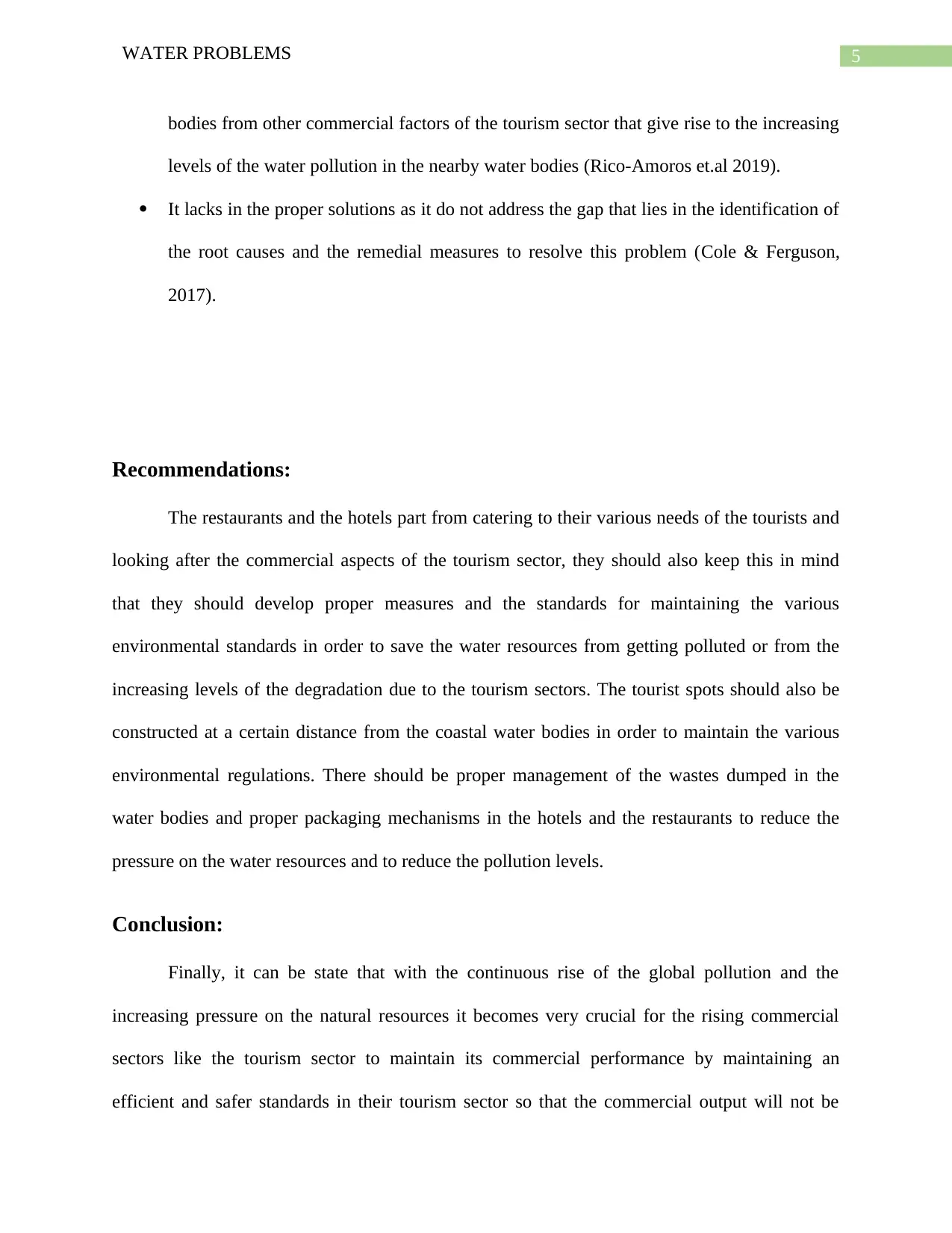
5WATER PROBLEMS
bodies from other commercial factors of the tourism sector that give rise to the increasing
levels of the water pollution in the nearby water bodies (Rico-Amoros et.al 2019).
It lacks in the proper solutions as it do not address the gap that lies in the identification of
the root causes and the remedial measures to resolve this problem (Cole & Ferguson,
2017).
Recommendations:
The restaurants and the hotels part from catering to their various needs of the tourists and
looking after the commercial aspects of the tourism sector, they should also keep this in mind
that they should develop proper measures and the standards for maintaining the various
environmental standards in order to save the water resources from getting polluted or from the
increasing levels of the degradation due to the tourism sectors. The tourist spots should also be
constructed at a certain distance from the coastal water bodies in order to maintain the various
environmental regulations. There should be proper management of the wastes dumped in the
water bodies and proper packaging mechanisms in the hotels and the restaurants to reduce the
pressure on the water resources and to reduce the pollution levels.
Conclusion:
Finally, it can be state that with the continuous rise of the global pollution and the
increasing pressure on the natural resources it becomes very crucial for the rising commercial
sectors like the tourism sector to maintain its commercial performance by maintaining an
efficient and safer standards in their tourism sector so that the commercial output will not be
bodies from other commercial factors of the tourism sector that give rise to the increasing
levels of the water pollution in the nearby water bodies (Rico-Amoros et.al 2019).
It lacks in the proper solutions as it do not address the gap that lies in the identification of
the root causes and the remedial measures to resolve this problem (Cole & Ferguson,
2017).
Recommendations:
The restaurants and the hotels part from catering to their various needs of the tourists and
looking after the commercial aspects of the tourism sector, they should also keep this in mind
that they should develop proper measures and the standards for maintaining the various
environmental standards in order to save the water resources from getting polluted or from the
increasing levels of the degradation due to the tourism sectors. The tourist spots should also be
constructed at a certain distance from the coastal water bodies in order to maintain the various
environmental regulations. There should be proper management of the wastes dumped in the
water bodies and proper packaging mechanisms in the hotels and the restaurants to reduce the
pressure on the water resources and to reduce the pollution levels.
Conclusion:
Finally, it can be state that with the continuous rise of the global pollution and the
increasing pressure on the natural resources it becomes very crucial for the rising commercial
sectors like the tourism sector to maintain its commercial performance by maintaining an
efficient and safer standards in their tourism sector so that the commercial output will not be
⊘ This is a preview!⊘
Do you want full access?
Subscribe today to unlock all pages.

Trusted by 1+ million students worldwide
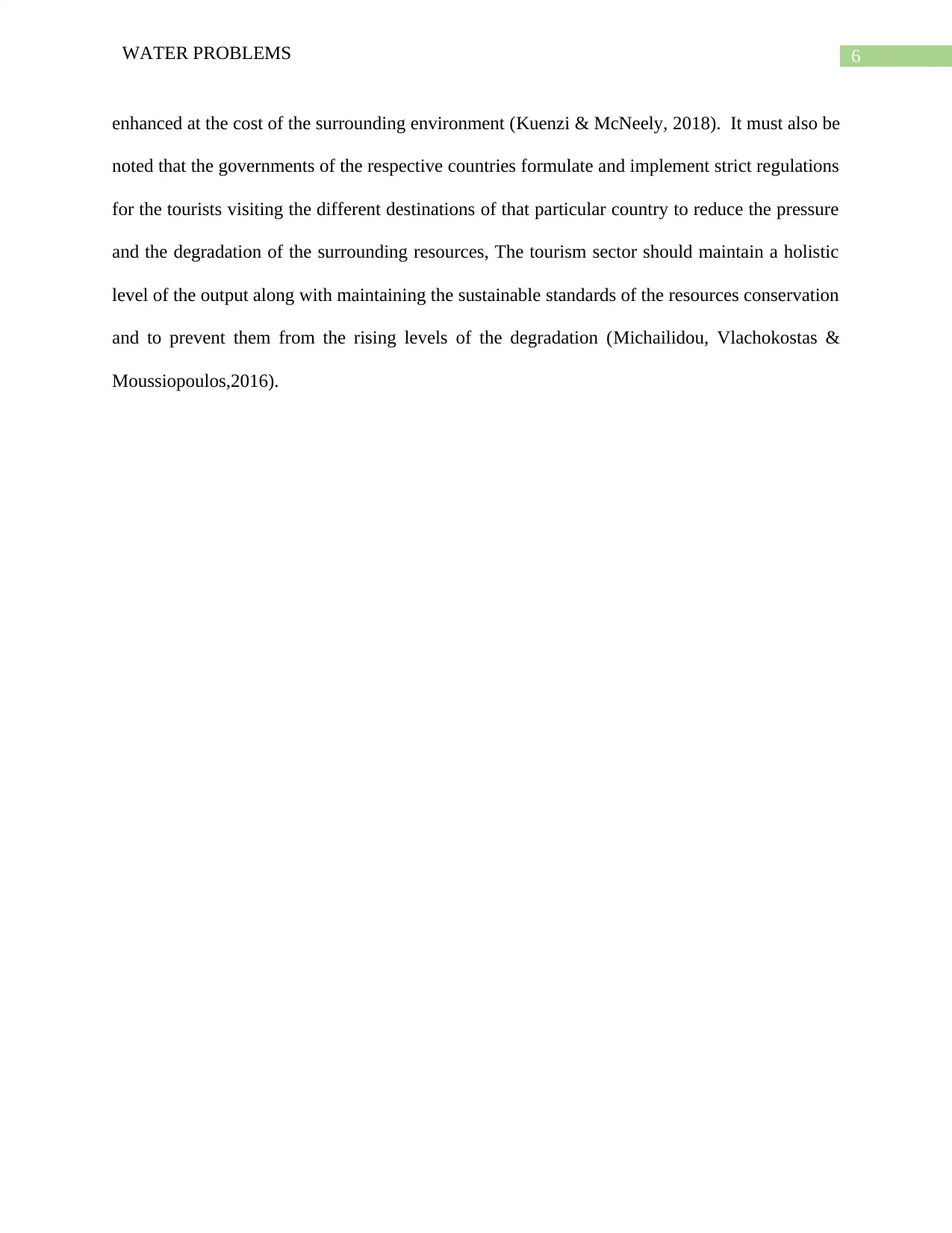
6WATER PROBLEMS
enhanced at the cost of the surrounding environment (Kuenzi & McNeely, 2018). It must also be
noted that the governments of the respective countries formulate and implement strict regulations
for the tourists visiting the different destinations of that particular country to reduce the pressure
and the degradation of the surrounding resources, The tourism sector should maintain a holistic
level of the output along with maintaining the sustainable standards of the resources conservation
and to prevent them from the rising levels of the degradation (Michailidou, Vlachokostas &
Moussiopoulos,2016).
enhanced at the cost of the surrounding environment (Kuenzi & McNeely, 2018). It must also be
noted that the governments of the respective countries formulate and implement strict regulations
for the tourists visiting the different destinations of that particular country to reduce the pressure
and the degradation of the surrounding resources, The tourism sector should maintain a holistic
level of the output along with maintaining the sustainable standards of the resources conservation
and to prevent them from the rising levels of the degradation (Michailidou, Vlachokostas &
Moussiopoulos,2016).
Paraphrase This Document
Need a fresh take? Get an instant paraphrase of this document with our AI Paraphraser
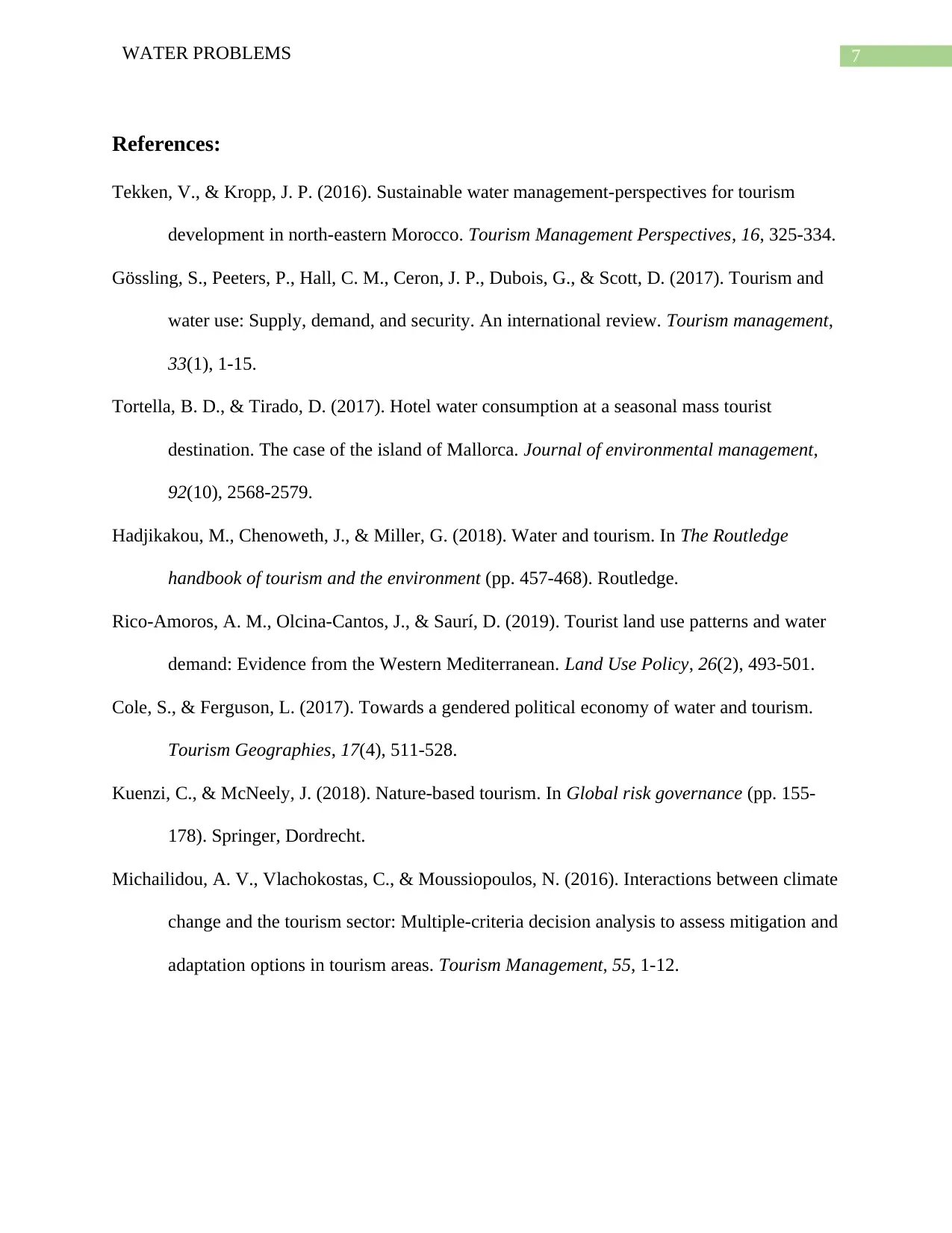
7WATER PROBLEMS
References:
Tekken, V., & Kropp, J. P. (2016). Sustainable water management-perspectives for tourism
development in north-eastern Morocco. Tourism Management Perspectives, 16, 325-334.
Gössling, S., Peeters, P., Hall, C. M., Ceron, J. P., Dubois, G., & Scott, D. (2017). Tourism and
water use: Supply, demand, and security. An international review. Tourism management,
33(1), 1-15.
Tortella, B. D., & Tirado, D. (2017). Hotel water consumption at a seasonal mass tourist
destination. The case of the island of Mallorca. Journal of environmental management,
92(10), 2568-2579.
Hadjikakou, M., Chenoweth, J., & Miller, G. (2018). Water and tourism. In The Routledge
handbook of tourism and the environment (pp. 457-468). Routledge.
Rico-Amoros, A. M., Olcina-Cantos, J., & Saurí, D. (2019). Tourist land use patterns and water
demand: Evidence from the Western Mediterranean. Land Use Policy, 26(2), 493-501.
Cole, S., & Ferguson, L. (2017). Towards a gendered political economy of water and tourism.
Tourism Geographies, 17(4), 511-528.
Kuenzi, C., & McNeely, J. (2018). Nature-based tourism. In Global risk governance (pp. 155-
178). Springer, Dordrecht.
Michailidou, A. V., Vlachokostas, C., & Moussiopoulos, Ν. (2016). Interactions between climate
change and the tourism sector: Multiple-criteria decision analysis to assess mitigation and
adaptation options in tourism areas. Tourism Management, 55, 1-12.
References:
Tekken, V., & Kropp, J. P. (2016). Sustainable water management-perspectives for tourism
development in north-eastern Morocco. Tourism Management Perspectives, 16, 325-334.
Gössling, S., Peeters, P., Hall, C. M., Ceron, J. P., Dubois, G., & Scott, D. (2017). Tourism and
water use: Supply, demand, and security. An international review. Tourism management,
33(1), 1-15.
Tortella, B. D., & Tirado, D. (2017). Hotel water consumption at a seasonal mass tourist
destination. The case of the island of Mallorca. Journal of environmental management,
92(10), 2568-2579.
Hadjikakou, M., Chenoweth, J., & Miller, G. (2018). Water and tourism. In The Routledge
handbook of tourism and the environment (pp. 457-468). Routledge.
Rico-Amoros, A. M., Olcina-Cantos, J., & Saurí, D. (2019). Tourist land use patterns and water
demand: Evidence from the Western Mediterranean. Land Use Policy, 26(2), 493-501.
Cole, S., & Ferguson, L. (2017). Towards a gendered political economy of water and tourism.
Tourism Geographies, 17(4), 511-528.
Kuenzi, C., & McNeely, J. (2018). Nature-based tourism. In Global risk governance (pp. 155-
178). Springer, Dordrecht.
Michailidou, A. V., Vlachokostas, C., & Moussiopoulos, Ν. (2016). Interactions between climate
change and the tourism sector: Multiple-criteria decision analysis to assess mitigation and
adaptation options in tourism areas. Tourism Management, 55, 1-12.
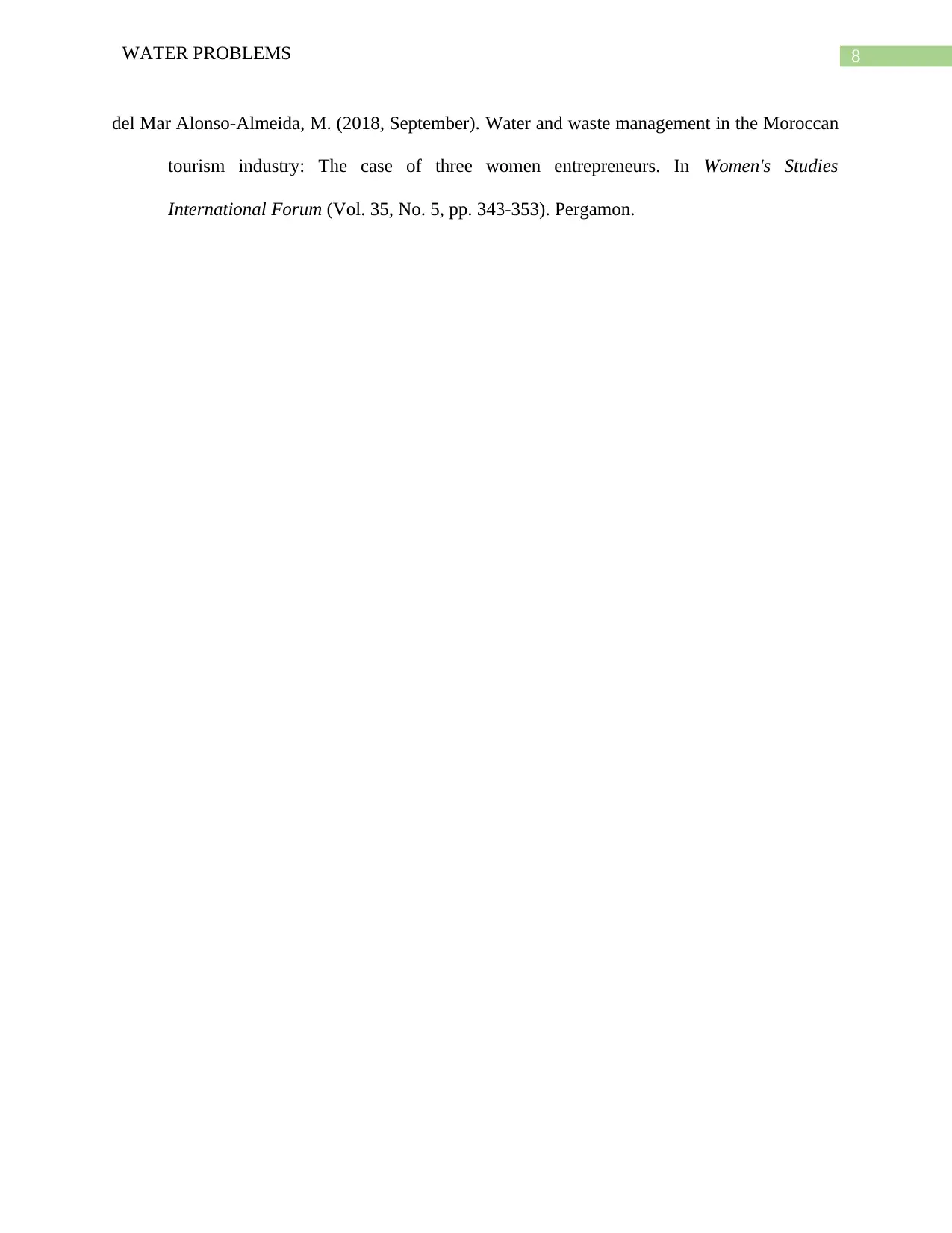
8WATER PROBLEMS
del Mar Alonso-Almeida, M. (2018, September). Water and waste management in the Moroccan
tourism industry: The case of three women entrepreneurs. In Women's Studies
International Forum (Vol. 35, No. 5, pp. 343-353). Pergamon.
del Mar Alonso-Almeida, M. (2018, September). Water and waste management in the Moroccan
tourism industry: The case of three women entrepreneurs. In Women's Studies
International Forum (Vol. 35, No. 5, pp. 343-353). Pergamon.
⊘ This is a preview!⊘
Do you want full access?
Subscribe today to unlock all pages.

Trusted by 1+ million students worldwide
1 out of 9
Related Documents
Your All-in-One AI-Powered Toolkit for Academic Success.
+13062052269
info@desklib.com
Available 24*7 on WhatsApp / Email
![[object Object]](/_next/static/media/star-bottom.7253800d.svg)
Unlock your academic potential
Copyright © 2020–2025 A2Z Services. All Rights Reserved. Developed and managed by ZUCOL.





